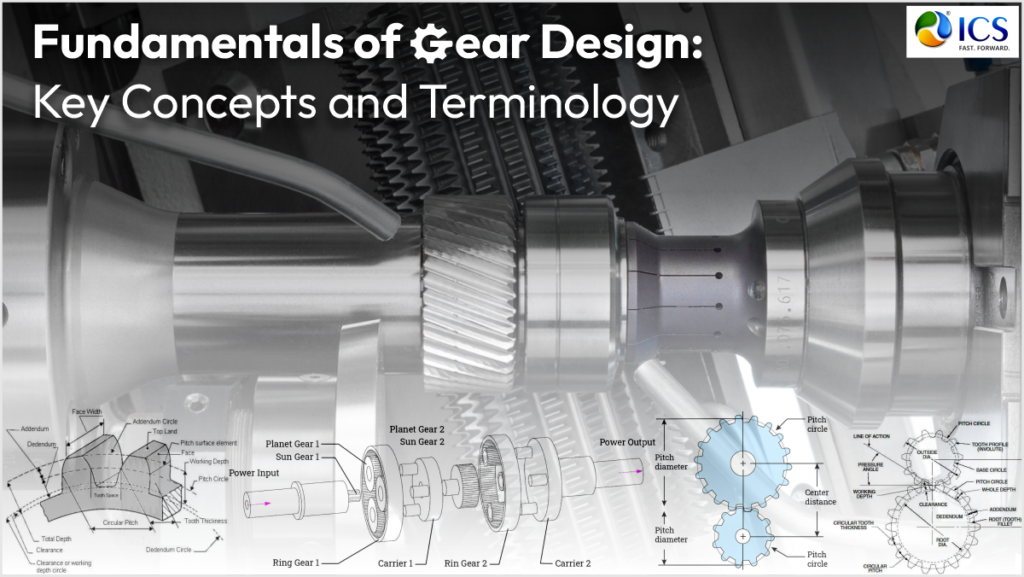Today, gears are one of the most used components in modern machinery due to the specialties they hold in transmitting power and motion in different operations. It can be from automobiles, which most of us use in our day-to-day lives, to the machinery used in industries to keep them running; gears are the unheralded engineering marvel. Some vital concepts must be comprehended to construct gears, some of which include the following terms. This blog aims to acquaint readers with the basics of gear design and how ICS can help you with your gear design requirements.
What Are Gears?
At their core, gears are mechanical devices with teeth that mesh together to transmit torque and rotational motion. They are used to modify speed, direction, or torque in a mechanical system. The design and functionality of gears depend on their type, size, material, and the way they interact with other components.
Types of Gears
There are various types of gears, each suited for specific applications. Below are the most common ones:
Spur Gears: These gears have straight teeth and are mounted on parallel shafts. They are ideal for applications requiring high efficiency and simplicity.
Helical Gears: With angled teeth, helical gears provide smoother and quieter operation compared to spur gears. They are used in applications that require high-speed operation.
Bevel Gears: Designed for intersecting shafts, bevel gears are commonly used in automotive differentials and industrial machinery.
Worm Gears: These consist of a worm (screw-like gear) and a worm wheel, offering high reduction ratios and compact designs.
Planetary Gears: Featuring central sun gear, surrounding planet gears, and an outer ring gear, these are ideal for high torque and compact applications.
Key Concepts in Gear Design
Module
The module is a critical parameter that defines the size of a gear tooth. It is the ratio of the pitch diameter to the number of teeth and is usually expressed in millimeters.
Pitch Circle
The pitch circle is the imaginary circle that represents the point of contact between two mating gears. It is essential in calculating gear ratios.
Pressure Angle
The pressure angle refers to the angle between the tooth profile and the line perpendicular to the pitch circle. Common pressure angles are 20° and 25°, and they influence the gear’s strength and efficiency.
Gear Ratio
The gear ratio is the ratio of the number of teeth on the driving gear to the number of teeth on the driven gear. It determines the output speed and torque.
Backlash
Backlash is the small clearance between mating gear teeth. While necessary to allow for lubrication and thermal expansion, excessive backlash can lead to inaccuracies and wear.
Material Selection
The material of a gear impacts its strength, durability, and performance. Common materials, including steel, brass, and plastic, are chosen based on application requirements.
Surface Finish and Heat Treatment
The surface finish of a gear affects its efficiency and noise levels. Heat treatments like carburizing or nitriding improve the gear’s hardness and wear resistance.
Common Challenges in Gear Design
Designing gears involves balancing various factors, such as strength, efficiency, noise levels, and cost. Some common challenges include:
● Stress Analysis: Ensuring the gear can withstand operational loads without failure.
● Noise and Vibration: Minimizing unwanted noise and vibration for smoother operation.
● Thermal Expansion: Accounting for temperature changes affecting gear dimensions and performance.
How Can ICS Help with Gear Design?
At ICS, you are assured of advanced knowledge regarding gear design since we have mastered the obstacles that businesses go through while developing effective mechanical systems. Whatever your gear requirement, automotive, aerospace, or industrial, our Gear Design Services are customized to suit your requirements. With a team of experienced engineers and cutting-edge technology, ICS offers:
● Custom Gear Design: We help you design gears that align with your performance and application requirements.
● Simulation and Testing: Our advanced tools allow us to simulate real-world conditions to optimize gear performance and durability.
● Material Optimization: We assist in selecting the best materials and heat treatment processes for your gear.
● Manufacturing Support: From prototyping to full-scale production, ICS provides comprehensive support to ensure your gears meet the highest quality standards.
Conclusion
Knowledge of gear design is crucial while thinking through how to develop effective and robust mechanical systems. From as simple as defining important terms to coming up with ways to address common issues, the design of gears is challenging yet fulfilling. ICS can make that process much easier for you, providing professional services to assist in the design of gears for your unique needs.
Connect with ICS today for accurate, long-lasting, and creative solutions to your gear concepts. We’d like to hear from you today. How can we assist you with your projects and advance your goals?
